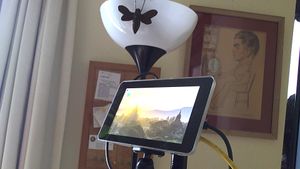Tenrec: Difference between revisions
Brian Wilson (talk | contribs) |
Brian Wilson (talk | contribs) mNo edit summary |
||
| Line 22: | Line 22: | ||
* Corsair GTX 240GB SSD | * Corsair GTX 240GB SSD | ||
* Startech USB3S2SAT3CB USB3.0-SATA3 cable w/UASP (lsusb id is 174c:55aa with ASMedia ASM1053E chipset) | * Startech USB3S2SAT3CB USB3.0-SATA3 cable w/UASP (lsusb id is 174c:55aa with ASMedia ASM1053E chipset) | ||
* Kensington USB3 hub | |||
<br clear=all/> | <br clear=all/> | ||
I drilled a couple holes in the bottom of the case, attached RAM mount hardware. | I drilled a couple holes in the bottom of the case, attached RAM mount hardware. | ||
I | I got a Kensington USB3 hub and I run it on a separate 5V supply, so now | ||
it's powering the Apple keyboard and a Startech USB3 SATA cable. | |||
The combination of USB3, SATA3, and a reasonably fast SSD is working well. | The combination of USB3, SATA3, and a reasonably fast SSD is working well. | ||
| Line 80: | Line 80: | ||
I had the lightning bolt low voltage warning almost continuously until I plugged in only a hub to the USB ports. | I had the lightning bolt low voltage warning almost continuously until I plugged in only a hub to the USB ports. | ||
I am using a 5V 4A switching supply and a USB-C cable. My power meter says it's pulling just over an amp at 5. | I am using a 5V 4A switching supply and a USB-C cable. My power meter says it's pulling just over an amp at 5.2 volts. | ||
== Software == | == Software == | ||
| Line 86: | Line 86: | ||
I installed Raspian Buster Lite on the 8GB SD card that I am using to boot. Then I copied the contents to the SSD and set it up to mount /dev/sda2 | I installed Raspian Buster Lite on the 8GB SD card that I am using to boot. Then I copied the contents to the SSD and set it up to mount /dev/sda2 | ||
as root. | as root. | ||
I hacked around with pulseaudio because it was not working. I used some notes from | |||
[https://raspberrypi.stackexchange.com/questions/639/how-to-get-pulseaudio-running here, on StackExchange.] | |||
I am using a Logitech camera for its microphone and the built in audio line out. | |||
=== Adding X11 === | === Adding X11 === | ||
Revision as of 01:21, 17 August 2020
Tenrec is a Raspberry Pi 4B

2020-May-09 arrived from Newark
I set it up as a build machine, with its faster processor and more RAM and SSD on USB3 it runs circles around violet (Pi 3B+) and of course my little Pi Zeroes.
Hardware
Cable management is always an issue with the Pi, they stick out everywhere! :-)

- 4GB 4B
- Seeed heatsink kit so cute, had to have one. Probably superfluous.
- 7" Pi touch screen from Element14
- Multicomp Pro case, clear
- Corsair GTX 240GB SSD
- Startech USB3S2SAT3CB USB3.0-SATA3 cable w/UASP (lsusb id is 174c:55aa with ASMedia ASM1053E chipset)
- Kensington USB3 hub
I drilled a couple holes in the bottom of the case, attached RAM mount hardware.
I got a Kensington USB3 hub and I run it on a separate 5V supply, so now it's powering the Apple keyboard and a Startech USB3 SATA cable.
The combination of USB3, SATA3, and a reasonably fast SSD is working well.
Quirks tests
set quirks=174c:55AA in /boot/cmdline.txt then run sudo ./Storage.sh and observe the results
Category Test Result HDParm Disk Read 162.96 MB/s HDParm Cached Disk Read 161.84 MB/s DD Disk Write 163 MB/s FIO 4k random read IOPS ( KB/s) FIO 4k random write IOPS ( KB/s) IOZone 4k read 15504 KB/s IOZone 4k write 23439 KB/s IOZone 4k random read 15545 KB/s IOZone 4k random write 21437 KB/s
With quirks turned off, it's faster
Category Test Result HDParm Disk Read 270.66 MB/s HDParm Cached Disk Read 265.18 MB/s DD Disk Write 166 MB/s FIO 4k random read IOPS ( KB/s) FIO 4k random write IOPS ( KB/s) IOZone 4k read 16087 KB/s IOZone 4k write 20849 KB/s IOZone 4k random read 16183 KB/s IOZone 4k random write 23324 KB/s
Screen and touch screen rotation
In this case, the 7" screen is upside down. You can fix this! https://raspberrypiprojects.com/raspberry-pi-rotate-touch-screen/ Also the image did not fill up the screen, perhaps it was defaulting to 640x480?
In /boot/config.txt,
lcd_rotate=2 framebuffer_width=800 framebuffer_height=480
On the login screen with these settings there is a white band on the right, one or two pixels wide but I don't care. It goes away after login.
Power
I had the lightning bolt low voltage warning almost continuously until I plugged in only a hub to the USB ports. I am using a 5V 4A switching supply and a USB-C cable. My power meter says it's pulling just over an amp at 5.2 volts.
Software
I installed Raspian Buster Lite on the 8GB SD card that I am using to boot. Then I copied the contents to the SSD and set it up to mount /dev/sda2 as root.
I hacked around with pulseaudio because it was not working. I used some notes from here, on StackExchange.
I am using a Logitech camera for its microphone and the built in audio line out.
Adding X11
I installed the window environment on the SSD. Also it goes without saying, emacs.
sudo -s dpkg --configure -a apt update apt full-upgrade reboot apt install emacs-nox apt install xserver-xorg xinit apt install raspberrypi-ui-mods reboot
Now I have a lightdm login screen, so I log in.
Adding Squeezelite
http://www.winko-erades.nl/installing-squeezelite-player-on-a-raspberry-pi-running-jessie/
Adding Alexa
Sample code is in /home/pi/alexa/.
I did a clean build after switching from Violet (Debian Stretch) to Tenrec (Debian Buster). Finally I did the build on the console on Tenrec after trying a few times from remote SSH sessions that got interrupted by random life events like dinner and walks.
Hooking up some NeoPixels
https://www.instructables.com/id/Alexa-Assistant-With-a-10-Raspberry-Pi-Zero-W-and-/